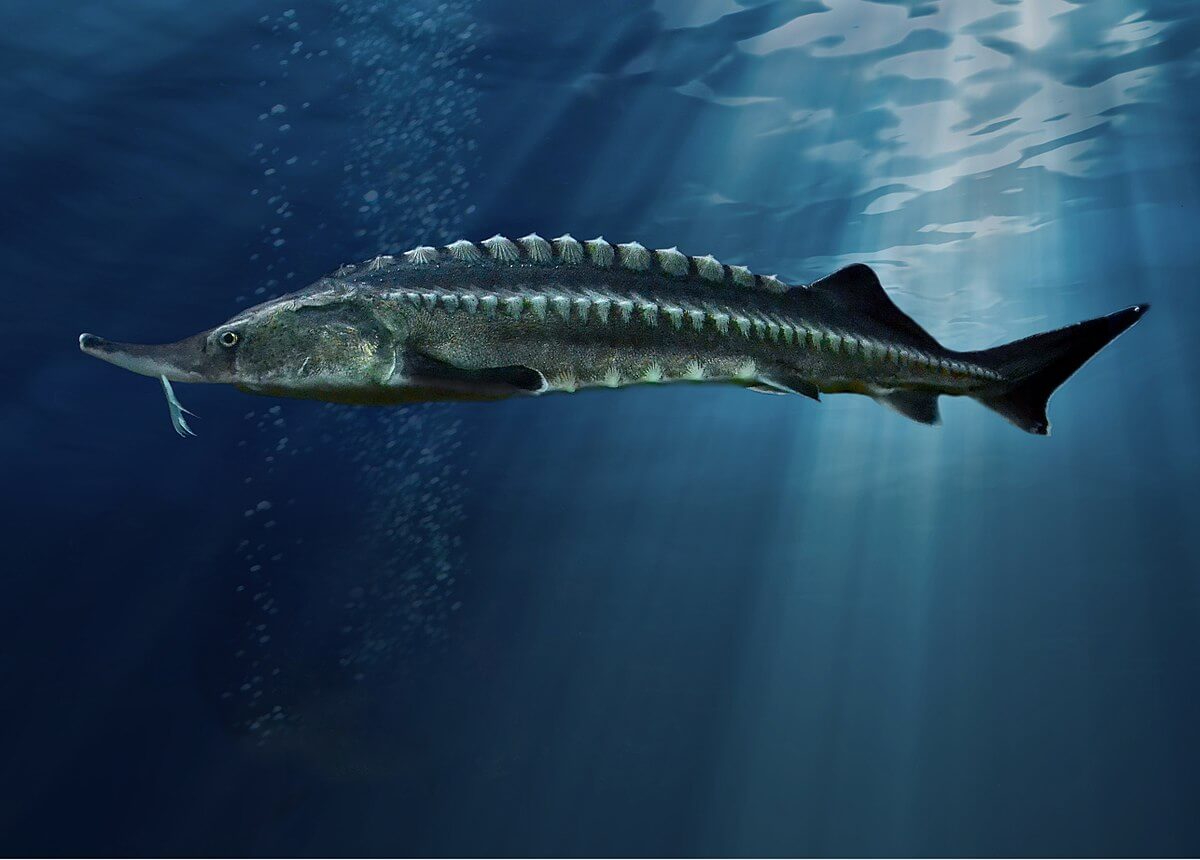
The beluga sturgeon, Huso Huso, is endemic to the Ponto-Caspian Sea region that includes the Caspian Sea (the largest inland body of water in the world) as well as the Sea of Azov and the Black Sea. The beluga sturgeon is one of the most long-lived of all vertebrate species. Reportedly it may have reached ages over 100 years. The scientific name of the beluga is Huso Huso. This appears to derive from an Old German word meaning skull, possibly in reference to the large armored head.
The Beluga Sturgeon (Huso Huso) is the largest growing sturgeon species, a true monster fish, one of the largest fish found in freshwater in the modern day.
Beluga sturgeon (Huso Huso) are listed as a “critically endangered” species on the IUCN Red List and are protected by CITES.
Behavior
Beluga congregate only during spawning times and seem to be a less gregarious species then other Ponto - Caspian sturgeon. Unlike other Ponto-Caspian sturgeon species beluga remain dispersed when not migrating (Levin 1997). Sturgeon species can endure long periods of starvation and often do not eat for long periods during spawning migrations (Beamesderfer & Farr 1997)
Food Habit
Adult beluga sturgeon are mainly piscivores, swimming at middle depths and preying mostly on pelagic fish species. This is unlike most other sturgeon species, which normally feed on benthic invertebrates while swimming along the bottom.
these fish’s mouths sit well underneath their head. Because of this, they primarily forage along the bottom when searching for prey. When this fish finds a potential meal, it does not bite at it. Instead, it creates a suction with its mouth.
Physical Description
Acipenseriformes are primitive fish that have a fossil record dating back to the Lower Jurassic (200 mya), with an origin perhaps even earlier in the Mesozoic (Bemis et al. 1997). The beluga sturgeon, Huso Huso and the Kaluga (Huso Dauricus) are the only members in the genus Huso, there are some doubts whether they are sister species.
H. dauricus First dorsal scute the largest. Barbels without foliate appendages. Fewer than 60 rays in dorsal fin. Found in the Amur Basin.
H. huso First dorsal scute the smallest. Barbels with foliate appendages. Usually not less than 60 rays in dorsal fin. Found in the basins of the Caspian, Black, and Adriatic Seas. The adult sturgeon fish is white, blue, and gray in color. Weighing up to 3,500 pounds (and stretching almost 20 feet), the beluga is the third largest living species of bony fish in the world.
Lifespan/Longevity
The beluga sturgeon is one of the most long-lived of all vertebrate species. Reportedly it may have reached ages over 100 years (Ono et al. 1983, Birstein 1993, Khodorevskya 2000). One reason for the sturgeon’s longevity is its size these are big fish with the Beluga sturgeon reaching over 20ft in length, because of their massive size a lot of other predators can’t or choose not to eat them leaving them open to flourish. Moreover, the adaptations of the sturgeon have made it a perfect survivor out living many other highly praised creatures. the structural adaptation mainly responsible for its success is its ability to travel from fresh to salt water giving it the ability to live in many different environments.
Conservation Status
Beluga sturgeon in the Caspian Sea is listed as Critically Endangered for the first time along with all of the other commercially important Caspian Sea species, which are the main producers of wild caviar.
Beluga sturgeon numbers have collapsed in recent decades due to overfishing and dams blocking their migratory routes and illegal trade in wild caviar and meat. Sturgeon and other migratory fish species are indicators of the ecological status of the river’s watercourses, especially concerning the function of the river as an ecological corridor. Therefore, transnational management and restoration actions to re-establish these corridors as migration routes and the fight against poaching, as well as stocking with indigenous species such as Belugas are essential until we have achieved a self-sustaining population again. Since the end of the 20th century, sturgeon farming has partially replaced meat and caviar production from fisheries. Now, Acipenseridae, including the species Huso Huso, are reared for different purposes, depending on the commercial supply, for meat and caviar production
Beluga Caviar
Caviar is graded according to the size of the eggs and the manner of processing. Grades are named for the types of sturgeon from which the eggs are taken.
Beluga caviar is by far the most highly prized and expensive of all the caviar varieties. Originating in the Caspian Sea, the beluga sturgeon (Huso Huso) lays the largest and softest roe of any sturgeon. These glorious shining eggs, ranging in color from light gray to black, are considered a luxury commodity, with a high price Caviar connoisseurs consider eating beluga caviar one of life’s greatest pleasures, raving about its impossibly smooth texture and life-enriching taste.

